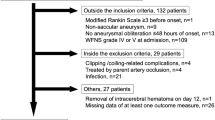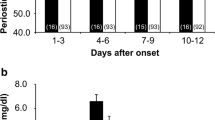Abstract
Cisternal irrigation with thrombolytic agents was used to prevent post-SAH vasospasm, but its role remained inconclusive. To verify effectiveness of papaverine (PPV) in preventing vasospasm, we studied relationship between inflammatory biologic markers and vasospasm. This prospective study included 121 patients with clipped anterior circulation aneurysms that had ruptured, and 372 control patients. Patients were divided into three groups according to cisternal irrigation method: simple drain, papaverine group, and urokinase (UK) group. Intercellular adhesion molecule-1 (ICAM-1) and vascular cell adhesion molecule-1 (VCAM-1) were determined in CSF and serum on days 3 and 7 after SAH. The PPV group showed similar incidence of vasospasm with UK group, but lower incidence than the simple drain group. The levels of ICAM-1 and VCAM-1 were significantly higher in the SAH group than in the control group. CSF and serum levels were more elevated on day 7 than day 3, and the degree of elevation were more marked when measured in the CSF than in the serum. However, there was no statistical difference between measured levels of ICAM-1 and VCAM-1, and vasospasm development. PPV cisternal irrigation was similarly effective as UK at preventing vasospasm. Although neither PPV nor UK irrigation could reduce the concentration of adhesion molecules compared with simple drain, we found levels of ICAM-1 and VCAM-1 were specifically elevated in the CSF. Therefore, further research should focus on anti-inflammation as a therapeutic target against cerebral vasospasm and on the CSF as the optimum place where such inflammatory action practically brought about.
Similar content being viewed by others
References
Mizoi K, Yoshimoto T, Takahashi A, Fujiwara S, Koshu K, Sugawara T (1993) Prospective study on the prevention of cerebral vasospasm by intrathecal fibrinolytic therapy with tissue-type plasminogen activator. J Neurosurg 78:430–437
Sasaki T, Ohta T, Kikuchi H, Takakura K, Usui M, Ohnishi H, Kondo A, Tanabe H, Nakamura J, Yamada K, Kobayashi K, Ohashi Y (1994) A phase II clinical trial of recombinant human tissue-type plasminogen activator against cerebral vasospasm after aneurysmal subarachnoid hemorrhage. Neurosurgery 35:597–605
Hamada J, Mizuno T, Kai Y, Morioka M, Ushio Y (2003) Microcatheter intrathecal urokinase infusion into cisterna magna for prevention of cerebral vasospasm: preliminary report. Stroke 31:2141–2148
Clatterbuck RE, Oshiro EM, Hoffman PA, Dietsch GN, Pardoll DM, Tamargo RJ (2002) Inhibition of vasospasm with lymphocyte function-associated antigen-1 monoclonal antibody in a femoral artery model in rats. J Neurosurg 97:676–682
Sills AK Jr, Clatterbuck RE, Thompson RC, Cohen PL, Tamargo RJ (1997) Endothelial cell expression of intercellular adhesion molecule 1 in experimental posthemorrhagic vasospasm. Neurosurgery 41:453–461
Kaynar MY, Tanriverdi T, Kafadar AM, Kacira T, Uzun H, Aydin S (2004) Detection of soluble intercellular adhesion molecule-1 and vascular cell adhesion molecule-1 in both cerebrospinal fluid and serum of patients after aneurysmal subarachnoid hemorrhage. J Neurosurg 101:1030–1036
Mocco J, Mack WJ, Kim GH, Lozier AP, Laufer I, Kreiter KT, Sciacca RR (2002) Rise in serum soluble intercellular adhesion molecule-1 levels with vasospasm following aneurysmal subarachnoid hemorrhage. J Neurosurg 97:537–541
Dalbasti T, Karabiyikoglu M, Ozdamar N, Oktar N, Cagli S (2001) Efficacy of controlled-release papaverine pellets in preventing symptomatic vasospasm. J Neurosurg 95:44–50
Shiokawa K, Kasuya H, Miyajima M, Izawa M, Takakura K (1998) Prophylactic effect of papaverine prolonged-release pellets on cerebral vasospasm in dogs. Neurosurgery 42:109–116
Ito U, Tomita H, Yamazaki S, Takada Y, Inaba Y (1986) Enhanced cisternal drainage and cerebral vasospasm in early aneurysm surgery. Acta Neurochir (Wien) 80:18–23
Kodama N, Sasaki T, Kawakami M, Sato M, Asari J (2000) Cisternal irrigation therapy with urokinase and ascorbic acid for prevention of vasospasm after aneurysmal subarachnoid hemorrhage. Outcome in 217 patients. Surg Neurol 53:110–118
Mizuno T, Hamada J, Kai Y, Todaka T, Morioka M, Ushio Y (2003) Intrathecal urokinase through a microcatheter into the cistern magna to prevent cerebral vasospasm: experimental study in dogs. Am J Neuroradiol 24:613–618
Sasaki T, Kodama N, Kawakami M, Sato M, Asari J, Sakurai Y, Watanabe K, Onuma T, Matsuda T (2000) Urokinase cisternal irrigation therapy for prevention of symptomatic vasospasm after aneurysmal subarachnoid hemorrhage: a study of urokinase concentration and the fibrinolytic system. Stroke 31:1256–1262
Usui M, Saito N, Hoya K, Todo T (1994) Vasospasm prevention with postoperative intrathecal thrombolytic therapy: a retrospective comparison of urokinase, tissue plasminogen activator, and cisternal drainage alone. Neurosurgery 34:235–245
Steinberg GK, Vanefsky MA, Marks MP, Adler JR Jr, Koenig GH (1994) Failure of intracisternal tissue plasminogen activator to prevent vasospasm in certain patients with aneurysmal subarachnoid hemorrhage. Neurosurgery 34:809–814
Han DH, Bai GY, Yang TK, Sim BS, Kwak YG, Kim CJ (2007) The effect of papaverine on ion channels in rat basilar smooth muscle cells. Neurol Res 29:544–550
Platz J, Baráth K, Keller E, Valavanis A (2008) Disruption of the blood-brain barrier by intra-arterial administration of papaverine: a technical note. Neuroradiology 50:1035–1039
Rath GP, Mukta Prabhakar H, Dash HH, Suri A (2006) Haemodynamic changes after intracisternal papaverine instillation during intracranial aneurysmal surgery. Br J Anaesth 97:848–850
Smith WS, Dowd CF, Johnston SC, Ko NU, DeArmond SJ, Dillon WP, Setty D, Lawton MT, Young WL, Higashida RT, Halbach VV (2004) Neurotoxicity of intra-arterial papaverine preserved with chlorobutanol used for the treatment of cerebral vasospasm after aneurysmal subarachnoid hemorrhage. Stroke 35:2518–2522
Cannella B, Raine CS (1995) The adhesion molecule and cytokine profile of multiple sclerosis lesions. Ann Neurol 37:424–435
Granert C, Raud J, Xie X, Lindquist L, Lindbom L (1994) Inhibition of leukocyte rolling with polysaccharide fucoidin prevents pleocytosis in experimental meningitis in the rabbit. J Clin Invest 93:929–936
Polverini PJ (1996) Cellular adhesion molecules. Newly identified mediators of angiogenesis. Am J Pathol 148:1023–1029
Abe Y, Sugisaki K, Dannenberg AM Jr (1996) Rabbit vascular endothelial adhesion molecules: ELAM-1 is most elevated in acute inflammation, whereas VCAM-1 and ICAM-1 predominate in chronic inflammation. J Leukoc Biol 60:692–703
Polin RS, Bavbek M, Shaffrey ME, Billups K, Bogaev CA, Kassell NF, Lee KS (1998) Detection of soluble E-selectin, ICAM-1, VCAM-1, and L-selectin in the cerebrospinal fluid of patients after subarachnoid hemorrhage. J Neurosurg 89:559–567
Rothoerl RD, Schebesch KM, Kubitza M, Woertgen C, Brawanski A, Pina AL (2006) ICAM-1 and VCAM-1 expression following aneurysmal subarachnoid hemorrhage and their possible role in the pathophysiology of subsequent ischemic deficits. Cerebrovasc Dis 22:143–149
Ryba M, Jarzabek-Chorzelska M, Chorzelski T, Pastuszko M (1992) Is vascular angiopathy following intracranial aneurysm rupture immunologically mediated? Acta Neurochir (Wien) 117:34–37
Acknowledgments
This work was supported by the research fund of Hanyang University (HY-2011-MC).
Conflict of interest
There are no conflicts of interests, no funding or any form of financial support.
Author information
Authors and Affiliations
Corresponding author
Rights and permissions
About this article
Cite this article
Kim, J.H., Yi, HJ., Ko, Y. et al. Effectiveness of papaverine cisternal irrigation for cerebral vasospasm after aneurysmal subarachnoid hemorrhage and measurement of biomarkers. Neurol Sci 35, 715–722 (2014). https://doi.org/10.1007/s10072-013-1589-0
Received:
Accepted:
Published:
Issue Date:
DOI: https://doi.org/10.1007/s10072-013-1589-0




